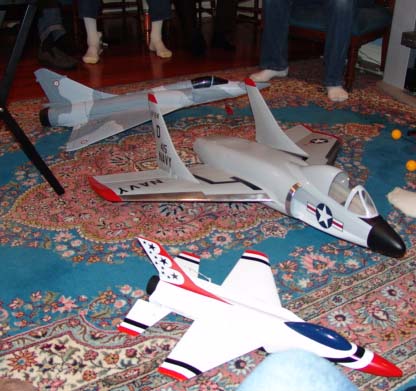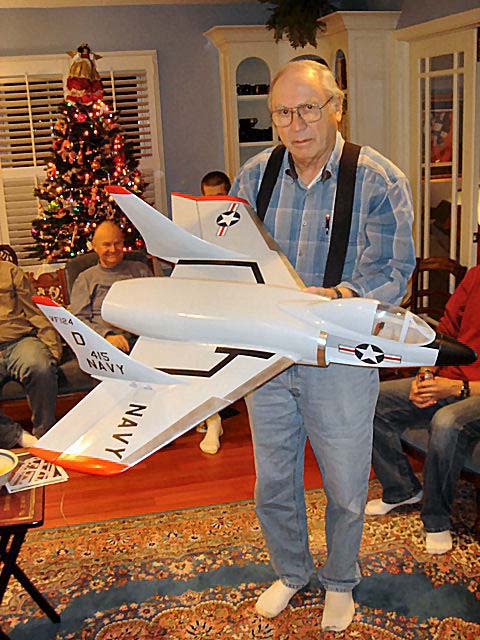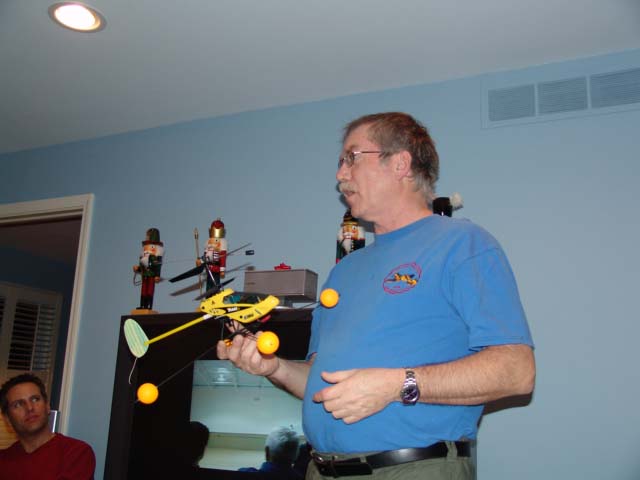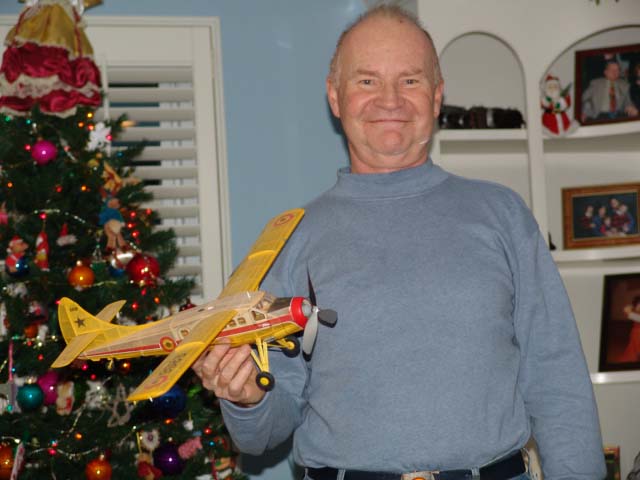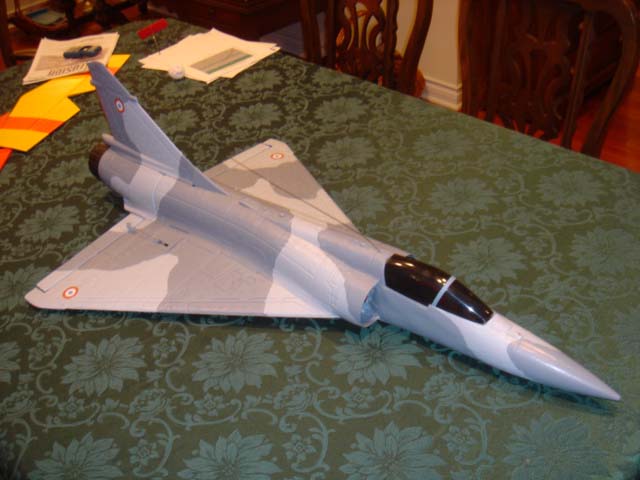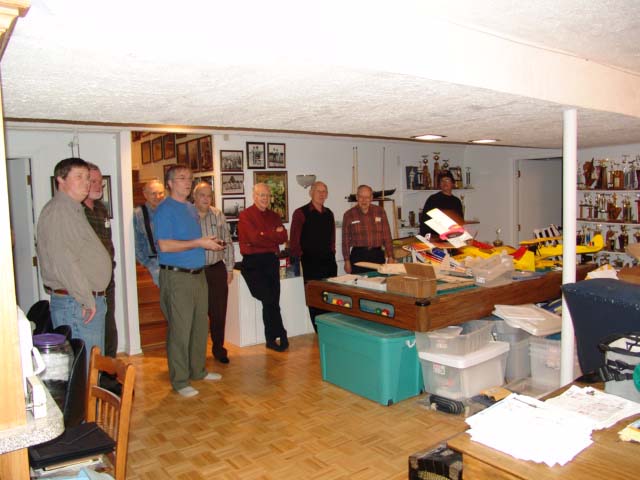Multiplex EasyStar RTF
(Ready to Fly) Review II
By Ken Myers

Forward: Exactly two years ago this month, I published this review in the Ampeer. At the end of the flying season 2005, I had a chance to fly two rank beginners on this plane for several hours. They both did extremely well. One of them was doing take offs from my hand launch and landings by the end of his session! I still rate this THE best RTF model on the market for the beginner to R/C.
I did have a few "issues" with the original model, particularly the charger, but that has been rectified by Hitec/Multiplex USA. This is an edited version of the original article with the new charger information provided.
The Multiplex EasyStar RTF is marketed as a buy it, fly it, ready to fly designed for beginners. In my quest for a good R/C trainer for the beginner, I ordered the Multiplex EasyStar RTF from Northeast Sailplane on December 5, 2003. I had read a review of this plane by Jim Rayven in the December 2003 issue of Quiet Flyer, and it had piqued my interest.
The plane comes as a complete package including the airframe, radio, charger, power system and flight battery. I was curious as to whether it could live up to its aspirations of being an excellent trainer plane for a beginner for under $200, as many planes marketed in this category are not!
Jim's review was for the airframe and motor/prop combination only. He supplied his own R/C equipment, flight battery and charger. As with most articles, I felt it was short on some of the information that I wanted to know. It did not include some niceties like RPM and amp draw of the supplied motor and prop combination.
The amp draw number became important to me as I waited for my EasyStar to show up. I decided to put the motor constants (Kv = 3026, Io = 0.7 Rm = 0.357 Wt.=2.6 oz/73.7g via Motocalc data) for the Permax
400 6v (the supplied motor) into my spreadsheet to check the performance of the motor. The complete power setup, provided in the RTF version, also includes a Multiplex Pico X-08 ESC (electronic speed control) w/BEC (battery eliminator circuit). The ESC is rated, by the supplier, at 8 amps continuous and 11 amps maximum.
I didn't like the numbers that I saw when I ran my spreadsheet data. It seems that this motor is not very efficient, even for a low efficiency S400 type.
As it turned out, this became totally irrelevant. The motor is "efficient enough" and training flight times average well over 12 minutes with the supplied 600mAh NiCad pack. KM Feb. 2006
The supplier quoted the wing area as a questionable 390 sq.in./25.16 dm2, while Ray's review said 372 sq.in./24 dm2.
Supplier data: (was on the Northeast Sailplane site at the time of the original review)
Northeast Sailplane no longer carries this plane, but a search of the Internet will show many suppliers, including Hobby Lobby. Be sure to get the RTF version, not the one that is the plane and other equipment supplied by Hobby Lobby. It is cheaper that way, and will do just as well. KM Feb. 2006
Skill Level: BEG/BEG
Wingspan: 54 in.
Wing area: 390 sq in?
Weight: 24 oz.
Wing loading: 9 oz/ft?
Airfoil: undercambered
Motor: Speed 400
Battery: 7- 8 cell 500-1050 Nicad-NiMH
Ray's review data:
Description: Park Flyer Motor Glider
Skill Level: Beginner
Wingspan: 54 in.
Wing area: 372 sq. in.
Weight: 22.5 oz.
Wing loading: 8.7 oz/ft
Motor: Speed 400 direct drive
Battery: 7-cell 600 mAh Nicad
Propeller: 5x4
Ray called it a Park Flyer, but at the end of his article he recanted by saying, "An athletic field, while suitable for typical park flyers, would generally be too small for this model."
For the beginner, this plane needs a very large, clear area to glide into and fly around. KM Feb. 2006
When all of the contents were removed from the box, there was a little black piece of plastic lying on the bottom. The plastic piece turned out to be part of the canopy/hatch hold-down. It had broken off the canopy/hatch in shipping. I used baking soda and CA glue to "repair" the broken part. A beginner might not know how to have done that, but a piece of tape would have worked to hold the canopy/hatch onto the fuselage.
I was surprised, while reading through the instructions, that there was no mention made of how to assemble the wing and spar and affix the wing to the plane. I knew the spar, which had been taped to the top of the box, had to go into one wing panel, and then that wing panel was inserted into the fuselage.
The other wing panel was slipped over the spar and then inserted into its slot in the fuselage. The plane now had a wing. The snug fit of the parts is intended to keep the wing in place.
A couple of Radio Shack little round magnets could be used to hold the canopy/hatch in place. KM Feb. 2006
Before I could affix the tail-feathers, which is the first step listed in the instructions, I had to use two pairs of pliers to straighten the rudder pushrod. The manual says to attach the tail-feathers using the supplied, and already in place, double-sided tape. This proved problematic, as removing the paper covering from the double-sided tape was not an easy task. A sharp, pointy kitchen knife did not work well.
My solution was to use a single-edged razorblade to cut and lift a small portion of the protective paper that was covering the tape. Then I lifted the little "chunk" of paper pulling the rest of the protective covering with it.
I noticed that the elevator hinge felt very stiff, so I worked it back-and-forth several times before “sticking” the horizontal fin/elevator to the fuselage, using the wings as a guide to keep the tail aligned.
The horizontal and vertical fins were attached with the elevator and rudder pushrod wires through the pushrod connectors, but the pushrod connectors were not tightened. They would be tightened later in the neutral position when the radio was turned on for the first time.
The Hitec Focus III SS 3-channel 72 MHz AM radio was loaded with 8 AA Duracell batteries, which were supplied. The trims on the radio were centered, the transmitter turned on, and the flight battery plugged into the speed control. The pushrod connectors were tightened with the surfaces on the plane and the trim levers on the radio in neutral positions. It was then that I noticed that no one had set the radio control throws up in the "standard" way for this plane. The elevator was reversed! It is not a big deal to flick the reversing switch on the transmitter, but a beginner wouldn’t know this because nowhere in the instructions or radio manual is the "correct" movement mentioned. They could learn to fly in a "backwards" manner on the elevator stick. To the beginner it might seem "correct" to push the stick up to make the plane climb and pull it back to make it dive or go lower. Luckily, the rudder was correct, so the only problem would be when a self-taught beginner would have to relearn flying a plane with the elevator stick moving in the generally accepted direction. I know that you can learn to fly with the elevator stick moving in the "wrong" direction. Don't ask! It was 1962. I was a kid. I'd never been in a plane or cockpit and I had no one to help me.
Following the instructions, I had removed the battery for charging. Removing the battery was not easy, as access to the battery is not good, even for small hands. I found the battery to be a 6-cell pack made up of Sanyo N-600AACL cells. It weighs 4.93 oz./140g with leads, connector and Velcro®. The specification for the Sanyo N600AACL cell is 0.74 oz./21g with an internal resistance of 0.0247.
This pack bothered me. First, Jim had used a 7-cell 600AE pack (from photo) and the Northeast Sailplane information said, "7- 8 cell 500-1050
Nicad-NiMhd." Would there be enough power from 6-cell pack? Also, the 600AACL pack is about one ounce heavier than an equivalent 600AE pack. Since weight is critical to a good flying electric, this didn't make sense to me.
Now it does. For its intended purpose, it doesn't need a 7-cell pack. Once the plane reaches the best "teaching" speed, there is still plenty of throttle left. Increasing the throttle past a certain point, only increase the noise, not the climb rate. The heavier battery balances the plane perfectly!
I next commented on the charger that came with my version. It has been replaced with a much more adequate charger. See the charger note at the end of the article. KM Feb. 2006
With the battery charged, the plane was just about ready for its maiden flight. As I loaded the plane into the truck, I noticed that the receiver antenna was taped to the bottom of the fuselage for shipping. I pulled the receiver antenna free from the tape so that it could trail behind the aircraft. If I'd have left the antenna taped to the bottom of the fuselage, the range could have been reduced. There was no note in the instructions about freeing the antenna.
Just before I left for Clara Miller Park to test the plane, I checked the weather for Walled Lake on my computer. At 4:00 p.m. it was partly cloudy, 25 degrees F/-4 degrees C with a 14 mph/22.5 km-ph wind from the west. Not a great day for testing this type of plane.
After completing a range check, I pointed the nose of the plane into the wind and gave it a gentle toss. It flew straight away, climbing like a rocket. With a few passes and a lot of down trim, it was flyable in the bouncy air. The wind continued to pick up and blew my hat off, but the plane remained controllable in the "bumpy" air. With the cold temperature, wind chill and high wind velocity, I did not fly out the pack! I elected to land after 5 or 6 minutes. Landing a very lightly loaded plane is interesting in this type of wind. It did not want to come down. Finally, I forced it down into a flat belly landing. No harm done.
While flying the plane, I noticed that the ESC has a very small control range with this transmitter setup. It doesn't come on until the transmitter throttle lever reaches about half of its travel. The range of RPM change does seem adequate though, as it goes from slow, level flight to a good climb rate. The rudder and elevator have a "slow" or "sluggish" feel about them. This is good for a beginner, as the surface movements proved more than adequate to handle the bumpy winds the plane was tested in.
At home, I ran out the pack. It continued providing power for about two or three minutes before the automatic voltage cutoff on the ESC kicked in.
I couldn't do further flight-testing until December 26 because of days of constantly high winds. The second flight on the plane went well in the 8 mph wind. Snow had fallen on December 25, but conditions were supposed to improve through the day.
When I left for the park, conditions were; sunny, 23 degrees F/-5 degrees C, and winds from the WNW at 8 mph/13 km-ph. The flight went well with a smooth landing in the fresh fallen snow. The only problem was that the canopy/hatch hold-down had broken again, so the flight was made without the canopy/hatch.
I recharged the battery at home and fixed the canopy/hatch once again. Flight conditions for the third flight on the plane were; sunny, 24 degrees F/-4.5 degrees C with winds out of the west at 8 mph.
This flight lasted over 11 minutes. The flight consisted of lazy circles in front of me with the throttle reduced the whole time except for the initial climb to altitude. The throttle was always on and never shut off until the low-voltage circuit of the ESC cut it off. Landing was easy and gentle in the new fallen snow. Even though the air was a bit "bumpy", the plane showed no bad flying characteristics and would "right" itself when I allowed it to.
Next was more on the problems with the then supplied charger. I also noted that I changed the connectors from the supplies "Tamiya" type to APP. KM Feb. 2006
The Specifications on my particular example:
Weight RTF: 21.16 oz./600g (weighed on my digital scale - no decals)
Wing area: 372 sq.in./24 dm2 (going with what's in the manual - too hard to measure this odd shape. I tried.)
Wing loading: 8.19 oz./sq.ft.
Cubic Wing Loading: 5.2 oz./cu.ft. (park flyer range)
Prop: Gunther 4.92"x4.33"/125mm x 110mm
Estimated Radio Weight: (radio came pre-installed so couldn't weigh the components)
Hitec HAS-03MB: 0.81 oz./23g (from HitecRCD site)
2 each Multiplex Tiny-S Micro Servos: 0.6 oz./17g ea. - 1.2 oz./34g (from Multiplex site)
Multiplex Pico X-08 ESC: 0.28 oz./8g
Fudge factor: 5%
Estimated airborne total component weight: 2.4 oz./68g
Airborne radio component weight Percent of RTF weight: 11%
Estimated Power System Weight:
Battery weight (w/Tamiya-style connector, leads & Velcro®): 4.93 oz./140g (weighed on my digital scale)
Permax 400 6v: 2.6 oz./73g (Motocalc data)
Fudge factor: 5%
Estimated Power System Weight: 7.9 oz./224g
Estimated Power System Weight Percent of RTF weight: 37%
Completed Airframe Weight estimate: 10.86 oz./308g
Prop Diameter Factor: 0.9
Pitch Factor: 0.88
Motor testing showed, with a battery right off my SR Batteries peak charger, a static RPM of 11,600 and an 8.6 amp draw. The amps were dropping off very steadily as I shut down the motor. The numbers indicate that the ESC shouldn't be overworked as the prop unloads in the air, as well as the battery quickly moves to a more "equalized" state for most of the flight. At this static point, near the beginning of the flight, the battery is delivering about 57 watts, but only about 30 watts or less are being supplied to the prop!
Hits and Misses: A look at each of the components making up this flight training system.
Packaging:
Hits: It comes in an attractive box with a complete listing of what's inside. Bubble wrap surrounds the wing halves, horizontal fin/elevator and vertical fin/rudder. The spar was taped securely to the inside of the box top.
Misses: The antenna was shaken loose and could have possibly gouged or damaged the foam parts.
There seemed to be nothing holding the canopy/hatch onto the fuselage during shipping, allowing the canopy/hatch to bounce around and break part of the latching mechanism. The pushrods should have been secured so that they do not get bent during shipping.
The Plane:
Hits: It is an absolutely excellent design and very well executed in Elapor®, a crash resistant foam that can easily be repaired with CA glue. The motor battery is in the front of the fuselage. It cannot come forward and break anything in front of it in the event of a crash. The pusher motor configuration keeps the motor and prop out of harms way in the event of a crash. As setup from the factory, there is enough control to fly the airplane, but not so much that the beginner might over-control it. The aerodynamics provide a smooth flight with no unpredictable results or tip-stalls. It's docile and forgiving. If the pilot just lets go of the stick, it will level its wings. It assembles easily and well in just minutes. It has a clever, easy design for the servo placement and pushrod runs. The overall design is attractive. It has a reasonably clean aerodynamic design for flight efficiency.
Misses: Using the molded foam as the hinge material for the rudder and elevator puts unnecessarily high loads on the servos, especially the elevator servo. Battery access is not as good as it could be. By making the canopy/hatch and the top, front part of the fuselage all one-piece battery access would be easier. There are no slots or holes for cooling air to enter or exit the fuselage to cool the battery and ESC.
The Power System:
Hits: The chosen components help to make the price point, and work adequately.
Misses: The Permax 400 6v is not as efficient as other S400 6v motors. At full throttle in a climb, the motor is operating at about 50% efficiency, which means that half the power going into the motor is being wasted as heat energy. It also means a shorter motor run time on the same capacity battery pack.
This is not a MAJOR problem at all. As noted, it is efficient enough to do the intended job. KM Feb. 2006
The Multiplex Pico X-08 ESC is limited to 8 amp constant current applications, which means that it really shouldn't be used with other S400 type motors, unless the current is carefully controlled by the selection of the prop.
The Sanyo N600AACL is heavy for a 600mAh pack of Ni-Cads. This pack weighs about 5 oz./141g. To keep the balance right and have even longer flights, a better cell choice, is the Sanyo KR-1100AAU Ni-Cad, which has an 1100mAh capacity, internal resistance of 0.0195 and weight of 0.83 oz./23.5g. A 6-cell pack weighs about 5.4 oz./155g on my digital scale with leads and Velcro®. That's a small weight penalty to pay for almost twice the motor run time. The slight increase in weight does not affect the flight characteristics of this plane.
The Hitec CG-72S charger was the MAJOR flaw in this beginner's system and has been replaced. See note at the end of this article.
The Radio System:
Hits: This is a decent 3-channel radio system. It is a 72 MHz AM unit, which is fine. Since the transmitter uses eight AA dry cell batteries, it can be ready to go at anytime. You don't have to remember to put batteries on charge, just keep an extra 8-pack handy.
The receiver has a range of approximately 1/2 mile/0.8 km, which is about half the "standard" range of today's systems, but it has proved very adequate for this plane. The servos are light enough and powerful enough for this application.
Misses: The elevator switch, on the back of the transmitter, was in the wrong position for the way the servo was set up in the plane. The provided Hitec manual for the radio only states, "Check to see that the servos are moving in the correct direction. If not, change the servo direction with the reversing switches located on the back of the radio." Nowhere in the Hitec manual does it reference what the correct direction is! Since this radio and plane combination is aimed at the beginner, it would be nice to have information and diagrams on how to set up a rudder/elevator and aileron/elevator plane in the standard fashion.
The Instruction Manual:
Hits: There is a lot of useful information and great advice interspersed with the assembly steps.
Misses: The assembly steps are not clearly written in some places and are not in a logical order. While the plane is simple enough to assemble by looking at a picture of it and skimming the assembly instructions, the lack of information about the assembly of the wing, pushrod hook-up, and direction of the elevator deflection could be confusing to a beginner. There is no mention of the relationship of the elevator stick movement and the actual elevator movement. Many of the mentioned diagrams are not in the manual.
There is no USA version in instruction manual. The English version is for Great Britain and shows critical dimensions in the metric system only.
Overall, the Multiplex EasyStar RTF is an excellent RTF beginner's plane. The plane flies well, and a beginner can learn to fly it without instruction if he/she had to. I do not recommend learning to fly without an instructor, but it is possible. It is relatively easy to fly. Because of the material that it is made of, it should survive a few beginners' flying mistakes. It is relatively easily repaired with CA glue, making field repairs quite fast. The radio and power system can be moved to other, more advanced projects.
With the change in charger I can now call the EasyStar RTF package "excellent" for a beginner.
I still feel that cooling entry and exit points could be incorporated into the airframe design for the flight battery and ESC. Both the Multiplex instruction manual and Hitec radio manual need to be rewritten for clarity and completeness of information for the beginner, as well as including information in measuring units understood by the majority of USA citizens that may purchase this unit.
The manuals and information could have been rewritten or an addendum added to the USA release. I have no way of knowing that at this time. KM Feb. 2006
Tools used:
Single-edge razorblade
CA glue
Baking soda
Allen wrench (provided)
2 pairs of pliers
Internet sites referenced:
Multiplex EasyStar – Multiplex Site: www.multiplexusa.com/product_fs.htm
Multiplex EasyStar – Hobby Lobby International: www.hobby-lobby.com/easystar-rtf.htm
Quiet Flyer magazine site: www.quietflyer.com
HitecRCD site: www.hitecrcd.com
For metric conversions: www.metric-conversions.org
KR-1100AAU Note:
I purchased a dozen Sanyo KR-1100AAU cells from Cermark (www.cermark.com) for $2.80 each and made up a couple of 6-cell packs. The packs weighed 5.48 oz./155g with leads, APP/Sermos connectors and Velcro®. That brings the RTF weight to 21.66 oz./614g with the 6-cell KR-1100AAU pack, and the wing loading becomes 8.38 oz./sq.ft. There is absolutely no handling difference with this small change in weight and wing loading. Obviously duration is almost doubled!
After building the packs, they were put on a 1/10C charge for 14 hours to equalize them. I discharged them at one amp, the limit of my SR Batteries' Smart Charger, and found that one pack had 1062mAh in it and the other 1067 mAh.
Since the Sanyo1100AAU is supposed to have a lower internal resistance, I decided to repeat the static amp draw and RPM test to see if there was any change. The Whattmeter still showed 8.6 amps, but the RPM was 11,880, an almost 300 RPM increase over the 600 mAh battery.
The New Supplied Charger
Before redoing this review, I sent an email to Hitec/Multiplex and received a reply from Martin S. that said the new supplied charger is called the Auto Charger and is Multiplex Part number M92526. The details for the Auto Charger are; for any 4 to 7-cell Nicad packs, switchable outputs for 1A, 2A and 4A charge rates, input (Power Supply) 12 Volt. The photo indicates that this is a peak charger.
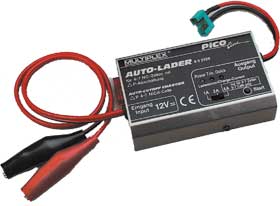
Photo from Multiplex USA site
Return to "What's In This Issue?"
Premature Lithium Polymer Battery "Death"
By Bob Kopski
25 W. End Dr.
Lansdale, PA 19446
I've gradually been building up my inventory and applications of Li-Po batteries over the past 2 plus years. Along the way I've used packs from 2-cell 340 mAh to 3-cell 3200's in a variety of planes.
I got into the habit of documenting pack behavior when "new" and thereafter doing an occasional data run. For my purposes, I chose to standardize on a 1C discharge to 3V/cell using the West Mountain Radio CBA device.
This process has revealed some disappointing information. First, it confirmed what we all know: that advertised pack capacity is almost always not true. Or is it? Since all but one of my 17 packs came up short on capacity in my 1C testing, I dug deeper. What I learned from an industry person is that Li-Po pack capacity is specified (by international standard) at a 0.2 C rate.
Great! Just what we need. Specsmanship for marketing purposes and not for anything useful to us! I never expect to test (or fly) at that useless 0.2C value - so I'll never know if all those labels lie or not!
But here is something even more disturbing - to me for sure and perhaps to all: it appears that all my newer "high (or higher) rate" Li-Po’s are dieing on the shelf.
As specific examples, in the April/May time frame of 2005 I purchased (3) Kokam 2000 3-cell 15C packs and (3) Kokam 3200 3-cell 20C packs - for me a huge investment. I flew these numerous times in the following months and it seemed each succeeding session was "weaker" than the preceding one.
Invoking the test scheme described above, I found that in all cases, the pack capacity noticeably decreased with time.
I might note here that my flight applications are all casual or "sport" and no peak current drains have exceeded about 12C. Routine charging was done with the Astro 109, the Triton, or the PolyCharge4.
Here is a tabulation of test results to date:
| Kokam 2.0 15C | "New AH" | "Now AH" |
| "A" | 1.91 | 1.57 |
| "B" | 1.90 | 1.69 |
| "C" | 1.84 | 1.62 |
| |
| Kokam 3.2 20C | "New AH" | "Now AH" |
| "A" | 3.06 | 2.78 |
| "B" | 3.02 | 2.86 |
| "C" | 2.55 | 2.49 |
To me, this is terrible performance from premium packs. As above, these packs are less than one year old and used relatively little. (Some actually have more test runs than flights.) But here is some comparative data that makes them look even worse. This data is on two, 2 1/2 year old, frequently flown Predator 1550's (now discontinued). (I think these were rated at 8C)
| Predator 1550 | "New AH" | "Now AH" |
| "A" | 1.49 | 1.45 |
| "B" | 1.49 | 1.42 |
This tells us that not all my Li-Po's "die on the shelf".
Finally, consider my newest "higher rate" pack - an Apogee 1.57Ah 10.5C. It's about 5 months old, and has been flown about 13 times.
| Apogee | "New AH" | "Now AH" |
| | 1.61 | 1.46 |
Summarizing, there was at least one pack (Apogee) on earth at one time that actually met label capacity - at a 1C test rate - but that didn't last. Next, it seems quite clear that my newer "higher rate" packs categorically "die on the shelf" - my huge investment is rapidly losing value. I'm sure glad I have at least 2 old packs whose capacity and overall performance can be counted on.
In case anyone wonders, yes - I did attempt "cell balancing" in several of the pack examples above. I had only limited improvements - it seems the cells within the packs were mostly reasonably balanced - at a "not so good" level. One improvement did occur in one Kokam 2000 15C pack when FMA serviced it with a replacement cell - that brought it all the way up to the disappointing performance shown in the table.
Of course, one variable in all this is "me". Could there be something I was not doing "right" in all the above? To test this I inquired of 2 E-modeling friends, one on each coast. Both are accomplished, knowledgeable E-flyers. One has a Kokam 3.2 20C pack, the other a 2.0 15C pack. They are just about the same age as mine. I asked if they had any experiences like mine. Both reflected a bit, rechecked, and YES, their packs are also dieing on the shelf - much like mine.
Ken, this brings me to a question you posed in the 01/06 Ampeer, RE: the new "best thing" for electric flight. My vote: MEANINGFUL, TRUTHFUL INDUSTRY STANDARD SPECIFICATIONS for Li-Polys. (We have had enough "snake oil", I feel.)
Here is an admittedly tough specification suggestion: Standardize Li-Po capacity as that displayed at a current level equal numerically to 1/2 the label (advertised) pack capacity. The specification should also assure that this capacity shall not degrade by more than 5% after at least 100 cycles at the rated performance limits, and not require more than one balancing charge every 20 cycles. Then price the packs at 25% to 50% higher than those with "snake oil" labels - I'd consider it well worth it!
Here is an example. Assume an advertised, labeled 1 Ah, 20C pack. This specification would require this pack display at least 1Ah capacity when tested at 0.5 amps, when new, and not less than 0.95 Ah following 100 cycles at a 20 amp continuous load.
Of course, I realize there are limitless ways to develop a Li-Po specification and for sure no industry member would want to glue himself to something as solid as this suggestion - it's just not good for business, right? Or is it?
I can't help but feel that as soon as someone begins to deliver against assured, meaningful, Li-Po specifications, his business would boom. But STOP! Since I've experience with only a few brands, maybe panacea is already here and I just don't know it. So I must ask: can anyone tell me if there presently exists such a supplier of truthfully labeled, durable Li-Po's - applicable to our use - with data to back it up?
I suspect not - for he'd likely now be the ONLY supplier remaining.
All the best to you, Ken, and all your readers too.
Bob
Return to "What's In This Issue?"
The January EFO Meeting
It was a wonderful night for the first EFO meeting of 2006 held at Rick Sawicki's house in Commerce, MI. The attendance was excellent, with a lot of "new" faces in attendance.
There were a lot of items for show and tell!
|



